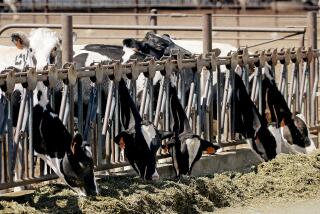Census Finds Farm Population Down 7%
- Share via
WASHINGTON — The nation’s hard-pressed farm population declined significantly last year, Census Bureau analysts and an Agriculture Department expert agreed Thursday, saying that a substantial part of the drop was caused by the current financial crisis in rural America.
The number of Americans living on farms plunged by 399,000 last year, from 5,754,000 in 1984 to 5,355,000--a 7% falloff that would be the sharpest in eight years, census analyst Diana DeAre said in an interview.
“This is the first significant change we’ve seen in the number of farmers since the early 1980s,” DeAre said.
Sampling Problems
While agreeing that the decline in farm population last year is consequential, Calvin L. Beale, head of population studies at the Agriculture Department, pegged it at 3.5% and contended that the census estimate was overstated because of sampling problems. In the 1960s, annual farm population losses averaged 4.6%, while in the 1970s they stood at 2.9%.
Beale blamed up to half of the decline on the economic depression in the Farm Belt that has plunged thousands of families deeply into debt, saying that the other half reflected a 45-year-old trend of technological changes that has greatly increased crop yields and thus reduced the need for farmers.
Moreover, he predicted, the drop-off will continue near the same rate this year.
Both DeAre and Beale said mainstream family farmers almost certainly were going out of business in disproportionately greater numbers than large corporate operators or part-time “hobby” farmers. But a complete statistical breakdown will not be available until a detailed study of the U.S. farm population is made in 1988.
Lag in Income Cited
In a report released Thursday, giving figures only through 1984, the Census Bureau said the nation’s farm population “continues to lag behind the non-farm population in family and household income.”
The study showed that a farm family had a median income of $18,925, only three-fourths that of non-farm families. And the poverty rate among those living on farms was 24%, compared with 15% for non-farm residents.
About one of every 41 persons, or 2.4% of the total population, lived on farms in 1984, the report found. Farm residents were older than the rest of the populace, with a median age of 35.5 years, contrasted with 31.0 for non-farm residents. The opposite was true more than 60 years ago: In 1920, farm residents’ median age was 20.7 years, contrasted with 26.9 years for all others.
Challenging the Census Bureau’s sampling techniques, Beale noted that in 1983 a census survey showed an increase in the farm population. But in 1984 the survey showed a decline of 33,000 people, which “struck me as ridiculously low given the severity of the farm crisis,” he said.
‘A High Bounce’
“I think there has been a real and actual decline in the farm population,” he added. “I just feel the ’84 number was a high bounce, as it were, in the sample. They’ve been changing the sample design during this time.”
DeAre defended the Census Bureau’s sampling, saying: “Obviously, it is a national sample and deals with a very small population group. We have had a change in the sample but, given the sampling error, the decline could be greater than the numbers shown, as well as less.”
She noted: “But there were no significant changes from 1980 to 1984. In 1985, we had a statistically significant decline for the first time.”
More to Read
Sign up for Essential California
The most important California stories and recommendations in your inbox every morning.
You may occasionally receive promotional content from the Los Angeles Times.








